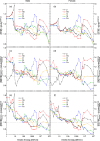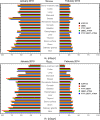Astronaut dose coefficients calculated using GEANT4 and comparison with ICRP123
- PMID: 40298992
- PMCID: PMC12350601
- DOI: 10.1007/s00411-025-01126-2
Astronaut dose coefficients calculated using GEANT4 and comparison with ICRP123
Abstract
Fluence-to-dose conversion coefficients are fundamental ingredients to calculate astronaut radiation dose in space. For this purpose, the conversion coefficients for isotropic radiation provided by the International Commission on Radiological Protection in Publication 123 (ICRP123) are widely used. Understanding the uncertainties in these coefficients is important for a precise calculation of radiation dose. In this work, we present a systematic study of unshielded dose coefficients calculated by means of the GEANT4 Monte Carlo simulation toolkit and the human voxel phantoms defined in ICRP Publication 110. Four GEANT4 physics lists, featured with two variations of electromagnetic and two variations of hadronic interaction models, were used in the study. Absorbed dose and dose equivalent coefficients with both the ICRP60 and NASA quality factors were calculated, for individual cosmic nuclei with charge from Z 1 to Z 28 and a kinetic energy range from 1 MeV/n to 100 GeV/n. The effective dose equivalent rates in free space at 1 AU were then calculated for each set of dose coefficients. The four effective dose equivalent rates calculated with each physics list agreed within , and on average they were larger than the ICRP123 results by and using the ICRP60 and the NASA quality factor, respectively. These results shed light on the systematic uncertainty of astronaut radiation exposure calculation, particularly from the physics interaction models.
Keywords: Dose conversion coefficient; Galactic cosmic ray; Linear energy transfer; Monte Carlo simulation; Space radiation.
© 2025. The Author(s).
Conflict of interest statement
Declarations. Conflict of interest: The authors declare that they have no conflict of interest.
Figures






Similar articles
-
Prescription of Controlled Substances: Benefits and Risks.2025 Jul 6. In: StatPearls [Internet]. Treasure Island (FL): StatPearls Publishing; 2025 Jan–. 2025 Jul 6. In: StatPearls [Internet]. Treasure Island (FL): StatPearls Publishing; 2025 Jan–. PMID: 30726003 Free Books & Documents.
-
Falls prevention interventions for community-dwelling older adults: systematic review and meta-analysis of benefits, harms, and patient values and preferences.Syst Rev. 2024 Nov 26;13(1):289. doi: 10.1186/s13643-024-02681-3. Syst Rev. 2024. PMID: 39593159 Free PMC article.
-
Carbon dioxide detection for diagnosis of inadvertent respiratory tract placement of enterogastric tubes in children.Cochrane Database Syst Rev. 2025 Feb 19;2(2):CD011196. doi: 10.1002/14651858.CD011196.pub2. Cochrane Database Syst Rev. 2025. PMID: 39968844
-
A rapid and systematic review of the clinical effectiveness and cost-effectiveness of paclitaxel, docetaxel, gemcitabine and vinorelbine in non-small-cell lung cancer.Health Technol Assess. 2001;5(32):1-195. doi: 10.3310/hta5320. Health Technol Assess. 2001. PMID: 12065068
-
Calculation of quality factors for space radiation at low Earth orbit: Monte Carlo-based microdosimetric approach.J Radiol Prot. 2025 Jun 24;45(2). doi: 10.1088/1361-6498/add89c. J Radiol Prot. 2025. PMID: 40367962
References
-
- Agostinelli S, Allison J, Amako K et al (2003) Geant4–a Simulation Toolkit. Nucl Instrum Methods Phys Res Sect A Acc Spectrom Detect Assoc Equip 506(3):250–303. 10.1016/S0168-9002(03)01368-8. (ISSN 0168–9002)
-
- Allison J, Amako K, Apostolakis J et al (2006) Geant4 developments and applications. IEEE Trans Nucl Sci 53(1):270–278. 10.1109/TNS.2006.869826
-
- Allison J, Amako K, Apostolakis J et al (2016) Recent developments in Geant4. Nucl Instrum Methods Phys Res Sect A Acc Spectrom Detect Assoc Equip 835:186–225. 10.1016/j.nima.2016.06.125. (ISSN 0168-9002)
-
-
Boschini MJ, Della Torre S, Gervasi M, Grandi D, Johannesson G, La Vacca G, Masi N, Moskalenko IV, Pensotti S, Porter TA, Quadrani L, Rancoita PG, Rozza D, Tacconi M (2020) Inference of the local interstellar spectra of cosmic-ray nuclei Z
 28 with the GalProp-HelMod framework. Astrophys J Suppl 250(2):27. 10.3847/1538-4365/aba901
-
PMC
-
PubMed
28 with the GalProp-HelMod framework. Astrophys J Suppl 250(2):27. 10.3847/1538-4365/aba901
-
PMC
-
PubMed
-
Boschini MJ, Della Torre S, Gervasi M, Grandi D, Johannesson G, La Vacca G, Masi N, Moskalenko IV, Pensotti S, Porter TA, Quadrani L, Rancoita PG, Rozza D, Tacconi M (2020) Inference of the local interstellar spectra of cosmic-ray nuclei Z
-
- Boschini MJ, Della Torre S, Gervasi M, Grandi D, Johannesson G, La Vacca G, Masi N, Moskalenko IV, Pensotti S, Porter TA, Quadrani L, Rancoita PG, Rozza D, Tacconi M (2021) The discovery of a low-energy excess in cosmic-ray iron: evidence of the past supernova activity in the local bubble. Astrophys J 913(1):5. 10.3847/1538-4357/abf11c - PMC - PubMed
Grants and funding
LinkOut - more resources
Full Text Sources

